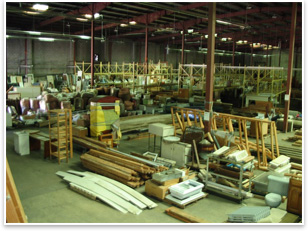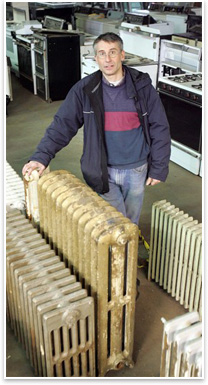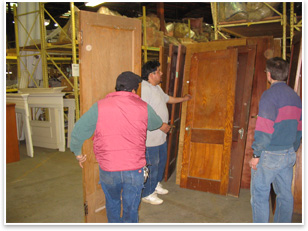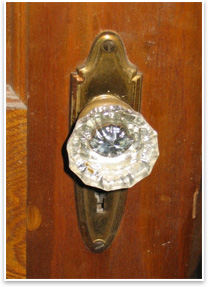
Architect’s
Business Promotes Use of Reclaimed Building Materials Summary: Community Forklift, a clearinghouse for reclaimed and salvaged materials near Washington, D.C., operated from a 40,000-square-foot warehouse by founder James Schulman, AIA, redirects materials bound for disposal to people who need low-cost building products. Community Forklift is also dedicated to promoting community-based sustainability initiatives and developing training, jobs, and career opportunities for low-income residents. One of the store’s main services for architects is that they can donate to get their clients a fair-market tax deduction, help them meet LEED™ standards, and be a part of a green building project.
Consider reuse for special projects “Reuse is not for the faint of heart and, of course, is not going to be appropriate for every client for every project. In fact, in most new construction, reused building materials are not necessarily appropriate,” Shulman says. “But architects do a lot of renovation work, small additions, and all kinds of things where they or their clients could strategically go and buy a nifty window from a reuse center like us. They also can come to a store to match a product already in the building.”
One of the store’s main services for architects, Mundell says, is that they can donate to get their clients a fair-market tax deduction, help them meet LEED™ standards, and be a part of a green building project. “And then, on the outgoing end, the do-it-your-selfers and the low-income folks are really able to buy a lot.”
How much does it cost? The formula is working for Community Forklift’s diverse clientele.
During the opening week, Schulman reports, “a Hispanic laborer
departed on foot with four 2x4s and was very happy with our prices.
Then, right after him, a chief of staff for a senator bought a bunch
of brick. She was also pleased.” Later on, Schulman says, she
donated building materials. |
||
Copyright 2006 The American Institute of Architects. All rights reserved. Home Page |
||
news headlines
practice
business
design
recent related
› AIA Portland to Develop, Move in to New Center for Architecture
› Being Less Bad Is Not Being Good
For more information, donation guidelines, or materials in stock, contact Community Forklift: 301-985-5180 or visit their Web site. Hours are Thursday-Saturday, 8 a.m.–4 p.m.
Mundell says the most requested items are:
› Ceramic floor tiles (homeowners)
› Reclaimed oak and pine wood flooring (homeowners and design firms)
› Radiators (for old homes, particularly for restorations)
› Decking (Mundell credits Long Fence for donating wood and composite
decking).
At its grand opening in April, Community Forklift held a “Blessing of the Green Builders.” They plan to make it an annual event
A
printer-friendly version of this article is available.
Download the PDF file.

 Community Forklift—operating with a small and dedicated team
since November 2005 just across the Washington, D.C., border in Edmonston,
Md.—is a nonprofit business at the crossroads of many issues
dear to Schulman’s heart. A wholly owned subsidiary and limited-liability
company, Community Forklift is an offshoot of a successful deconstruction
job training program run by parent organization Sustainable Community
Initiatives. That program helped underemployed city residents gain
basic construction skills by dismantling (not demolishing) wood and
masonry buildings. Lacking space for the reclaimed goods, the nonprofit
put its job training programs on hold to direct its resources toward
developing the retail outlet.
Community Forklift—operating with a small and dedicated team
since November 2005 just across the Washington, D.C., border in Edmonston,
Md.—is a nonprofit business at the crossroads of many issues
dear to Schulman’s heart. A wholly owned subsidiary and limited-liability
company, Community Forklift is an offshoot of a successful deconstruction
job training program run by parent organization Sustainable Community
Initiatives. That program helped underemployed city residents gain
basic construction skills by dismantling (not demolishing) wood and
masonry buildings. Lacking space for the reclaimed goods, the nonprofit
put its job training programs on hold to direct its resources toward
developing the retail outlet. Spreading the word
Spreading the word
 Specify—and educate
Specify—and educate “Fifteen years ago I was beating my head against the wall
trying to find clients interested in this kind of thing,” says
Schulman, who pursued sustainable design in his own architecture
firm before directing the nonprofit. “I do believe the American
public is far enough along now where their architect, interior designer,
or engineer can remind the client of these things and they will be
receptive. Architects are in a position not just to specify, but
to educate clients.”
“Fifteen years ago I was beating my head against the wall
trying to find clients interested in this kind of thing,” says
Schulman, who pursued sustainable design in his own architecture
firm before directing the nonprofit. “I do believe the American
public is far enough along now where their architect, interior designer,
or engineer can remind the client of these things and they will be
receptive. Architects are in a position not just to specify, but
to educate clients.” Diverse inventory
Diverse inventory